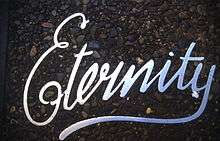Eternity (graffito)
The word Eternity was a graffito tag recorded over an approximate 35-year period from 1932 to 1967, written numerous times in chalk in the streets of Sydney, Australia. The word had been written by Arthur Stace, an illiterate former soldier, petty criminal and alcoholic who became a devout Christian in the late 1940s.

Arthur Stace
For years after his conversion up until his death in 1967, Arthur Stace walked the streets of Sydney at night writing the single word "Eternity" on walls and footpaths in his unmistakable copperplate handwriting. His identity remained unknown until it was finally revealed in a newspaper article in 1956. It is estimated Stace wrote the word over half a million times.[1]
Only two original Eternity inscriptions are known to exist. One is on a piece of cardboard Stace gave to a fellow parishioner, and is held by the National Museum of Australia in Canberra.[2] The other, and the only remaining inscription in situ, is inside the bell of the Sydney General Post Office clock tower.[3]
Legacy and cultural impact
After Stace's death, the Eternity signature lived on. Australian contemporary artist, illustrator and filmmaker Martin Sharp noticed it and celebrated Stace's one-man campaign in many of his works. More recently, some Australian Christian groups, including those at universities, have run evangelistic campaigns whose promotion involved chalking "Eternity", after Stace's fashion, on footpaths.
As part of the fireworks on Sydney Harbour to mark New Year's Day of the year 2000, the graffito "Eternity" was illuminated on the Sydney Harbour Bridge.[4][5] This moment was symbolically recreated later that year as part of the Sydney 2000 Olympics Opening Ceremony, beamed to billions of television viewers worldwide.
In 2001 the Council of the City of Sydney was granted a trademark (817532) on the script in order to protect it from indiscriminate commercial use.[6]
The newspaper Eternity was named after the tag. Founded in 2009, it has a broad circulation amongst Christian groups in Australia.
One of the works by English street artist Banksy during his October 2013 "residency" in New York City[7] depicts a worker washing away the Eternity tag.[8]
Sculptor, Will Coles, used the words on a concrete can. [9]
References
- Captivating and Curious, National Museum of Australia, Canberra, Australia, 2005, p74
- "Sign with the word "Eternity" written in white chalk on a piece of cardboard painted with blackboard paint". Stan Levit collection. National Museum of Australia. Retrieved 23 December 2014.
This is one of only two examples of Arthur Stace's Eternity still in existence.
- Fitzgerald, Shirley (2008). "Eternity". Dictionary of Sydney. Retrieved 25 January 2019.
- Dennis, Anthony (1 January 2000). "Millennium dawns". The Sydney Morning Herald. Fairfax Digital. Retrieved 23 December 2014.
- "Reuters photo of Arthur Stace's "Eternity" lit up Sydney's Habour Bridge". Sydney Morning Herald. 2000-01-01. Archived from the original on October 9, 2012.
- http://www.pastornet.net.au/stace/News.htm Archived August 30, 2007, at the Wayback Machine
- Hamilton, Keegan, "An Interview With Banksy, Street Art Cult Hero, International Man of Mystery". villagevoice.com, The Village Voice, 9 October 2013
- "Queens". instagram.com, Banksyny official Instagram. Retrieved 14 October 2013
- Will Coles official home page, street art gallery Retrieved 25/11/2018
External links
- Eternity: Stories from the emotional heart of Australia: The Eternity gallery at the National Museum of Australia
- Chalked Eternity sign by Arthur Stace at the National Museum of Australia
- Stace, Arthur Malcolm (1885–1967)- entry in the Australian Dictionary of Biography, National Centre of Biography, Australian National University
- Shirley Fitzgerald (2008). "Eternity". Dictionary of Sydney. Retrieved 2 October 2015. [CC-By-SA]